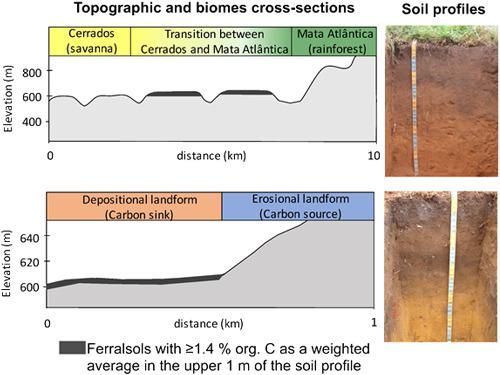当前位置:
X-MOL 学术
›
Earth Surf.Process. Land.
›
论文详情
Our official English website, www.x-mol.net, welcomes your
feedback! (Note: you will need to create a separate account there.)
Carbon stocks in umbric ferralsols driven by plant productivity and geomorphic processes, not by mineral protection
Earth Surface Processes and Landforms ( IF 2.8 ) Pub Date : 2021-10-11 , DOI: 10.1002/esp.5262 Pedro Martinez 1 , Lucas C. R. Silva 2 , Marcia Regina Calegari 3 , Plinio Barbosa Camargo 4 , Pablo Vidal‐Torrado 5 , Markus Kleber 1
Earth Surface Processes and Landforms ( IF 2.8 ) Pub Date : 2021-10-11 , DOI: 10.1002/esp.5262 Pedro Martinez 1 , Lucas C. R. Silva 2 , Marcia Regina Calegari 3 , Plinio Barbosa Camargo 4 , Pablo Vidal‐Torrado 5 , Markus Kleber 1
Affiliation

|
Umbric ferralsols (UF) have organic carbon stocks within the first 1 m of soil profile depth that are nearly double the size (~19 kg C m−2) compared to the average carbon stocks of all other ferralsols (~10 kg C m−2). Here, we investigate processes that allow UF to gain and maintain such extraordinary carbon stocks. Using the International Soil Research and Information Center database, complemented with recently published datasets, we show that the carbon saturation capacity of the clay + silt fractions in UF (22.8 ± 5.7 g C kg−1 soil, n = 59) does not exceed the carbon saturation capacity in other ferralsols (23.3 ± 6.2 g C kg−1 soil, n = 165), thus eliminating a particularly retentive mineral matrix as a possible explanation. Rather, carbon stocks were correlated with the thickness of A horizons (106 ± 49 cm, n = 59 in umbric versus 35 ± 22 cm, n = 165 in non-umbric ferralsols). We subsequently hypothesized that differences in A-horizon thickness arose from two pedogenic scenarios: (i) superior carbon accrual resulting from a unique vegetation cover capable of allocating large quantities of carbon to belowground plant organs; and (ii) geomorphic processes that led to carbon burial. We evaluated the plausibility of these scenarios considering landscape history and associated carbon flux rates, hillslope position, as well as δ13C values and Ti/Zr ratios for subsets of ferralsol profiles studied by us in a region that encompasses latitudes from 26 to 7°S in eastern Brazil. We found that exceptional carbon stocks were most prevalent in the gradual transition zone (ecotone) between savanna and rainforest, likely resulting from erosion–deposition processes, historic changes of vegetation cover composed of grasses and arboreal elements, and active bioturbation. We suggest that attempts to sequester carbon in non-umbric ferralsols will be most successful if they emulate or promote the biotic and abiotic processes prevalent in the savanna/rainforest ecotone.
中文翻译:

由植物生产力和地貌过程驱动的伞形铁溶胶中的碳储量,而不是矿物保护
Umbric ferralsols (UF) 在土壤剖面深度的前 1 m 内具有有机碳储量,与所有其他 ferralsols 的平均碳储量(~10 kg C m -相比,其尺寸几乎是两倍(~19 kg C m -2 ) 2 )。在这里,我们研究了使 UF 获得并维持如此非凡的碳储量的过程。使用国际土壤研究和信息中心数据库,并辅以最近发布的数据集,我们表明 UF(22.8 ± 5.7 g C kg -1土壤,n = 59)中粘土 + 粉砂部分的碳饱和能力不超过其他铁质溶胶中的碳饱和容量(23.3 ± 6.2 g C kg -1土壤,n = 165),因此消除了特别保留的矿物基质作为可能的解释。相反,碳储量与 A 层的厚度相关(106 ± 49 厘米,n = 59 在伞形中与 35 ± 22 厘米,n = 165 在非伞形铁溶胶中)。我们随后假设 A-horizon 厚度的差异源于两种成土情景:(i)独特的植被覆盖能够将大量碳分配给地下植物器官,从而产生优越的碳积累;(ii) 导致碳埋藏的地貌过程。我们评估了这些情景的合理性,考虑了景观历史和相关的碳通量率、山坡位置以及δ13我们研究的铁溶胶剖面子集的 C 值和 Ti/Zr 比率,该区域包括巴西东部 26 至 7°S 的纬度。我们发现异常碳储量在稀树草原和热带雨林之间的渐变过渡区(生态带)中最为普遍,这可能是由于侵蚀-沉积过程、由草和树栖元素组成的植被覆盖的历史变化以及活跃的生物扰动造成的。我们建议,如果能够模仿或促进稀树草原/热带雨林交错带中普遍存在的生物和非生物过程,那么在非伞形铁溶胶中封存碳的尝试将是最成功的。
更新日期:2021-10-11
中文翻译:

由植物生产力和地貌过程驱动的伞形铁溶胶中的碳储量,而不是矿物保护
Umbric ferralsols (UF) 在土壤剖面深度的前 1 m 内具有有机碳储量,与所有其他 ferralsols 的平均碳储量(~10 kg C m -相比,其尺寸几乎是两倍(~19 kg C m -2 ) 2 )。在这里,我们研究了使 UF 获得并维持如此非凡的碳储量的过程。使用国际土壤研究和信息中心数据库,并辅以最近发布的数据集,我们表明 UF(22.8 ± 5.7 g C kg -1土壤,n = 59)中粘土 + 粉砂部分的碳饱和能力不超过其他铁质溶胶中的碳饱和容量(23.3 ± 6.2 g C kg -1土壤,n = 165),因此消除了特别保留的矿物基质作为可能的解释。相反,碳储量与 A 层的厚度相关(106 ± 49 厘米,n = 59 在伞形中与 35 ± 22 厘米,n = 165 在非伞形铁溶胶中)。我们随后假设 A-horizon 厚度的差异源于两种成土情景:(i)独特的植被覆盖能够将大量碳分配给地下植物器官,从而产生优越的碳积累;(ii) 导致碳埋藏的地貌过程。我们评估了这些情景的合理性,考虑了景观历史和相关的碳通量率、山坡位置以及δ13我们研究的铁溶胶剖面子集的 C 值和 Ti/Zr 比率,该区域包括巴西东部 26 至 7°S 的纬度。我们发现异常碳储量在稀树草原和热带雨林之间的渐变过渡区(生态带)中最为普遍,这可能是由于侵蚀-沉积过程、由草和树栖元素组成的植被覆盖的历史变化以及活跃的生物扰动造成的。我们建议,如果能够模仿或促进稀树草原/热带雨林交错带中普遍存在的生物和非生物过程,那么在非伞形铁溶胶中封存碳的尝试将是最成功的。















































 京公网安备 11010802027423号
京公网安备 11010802027423号